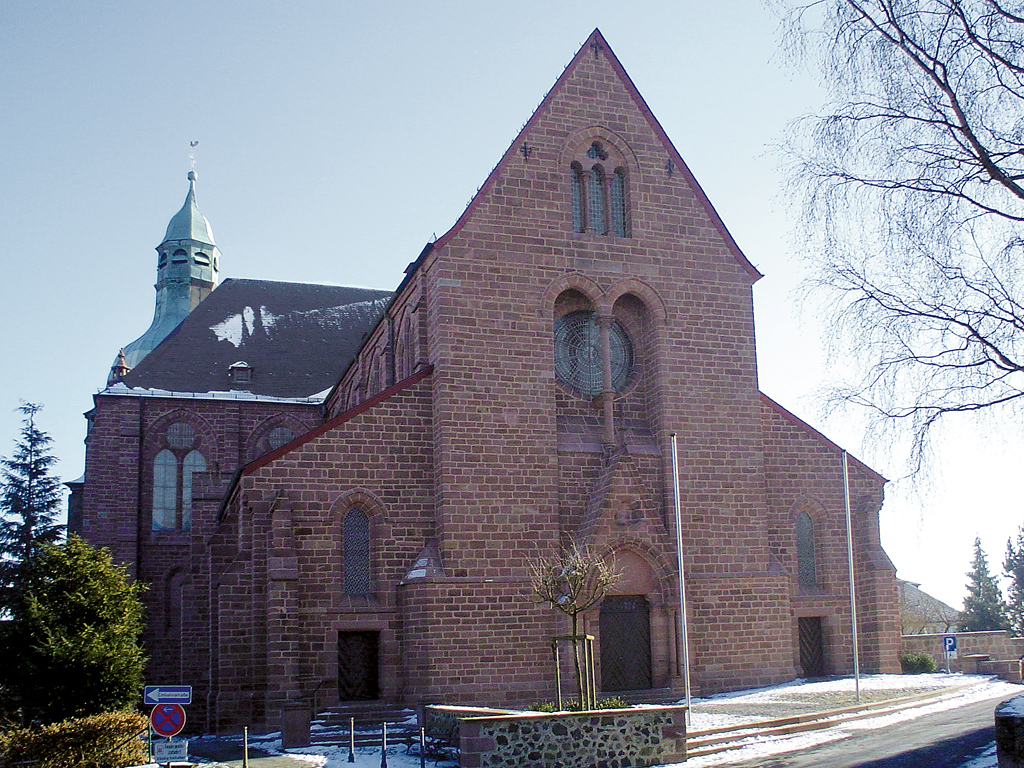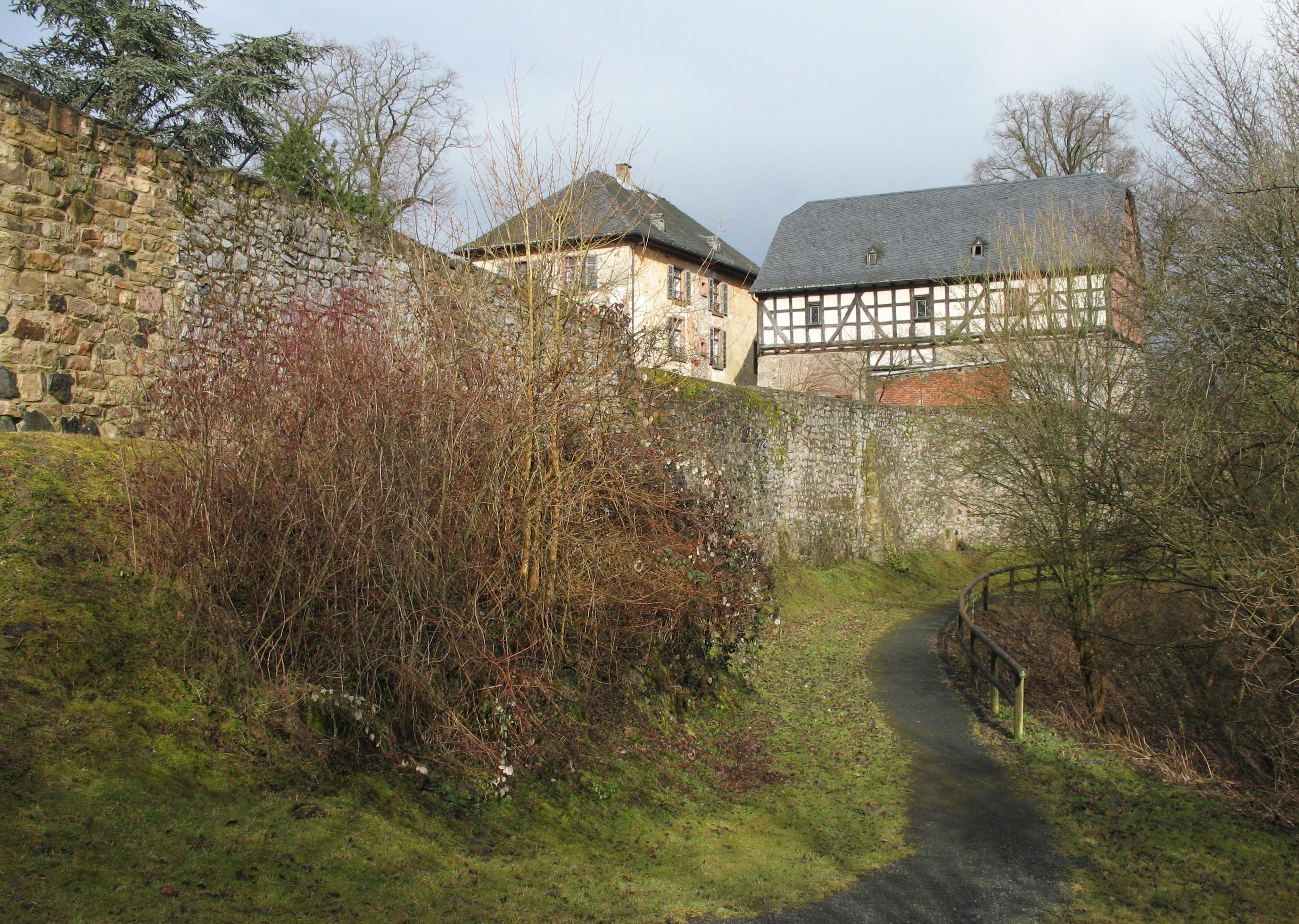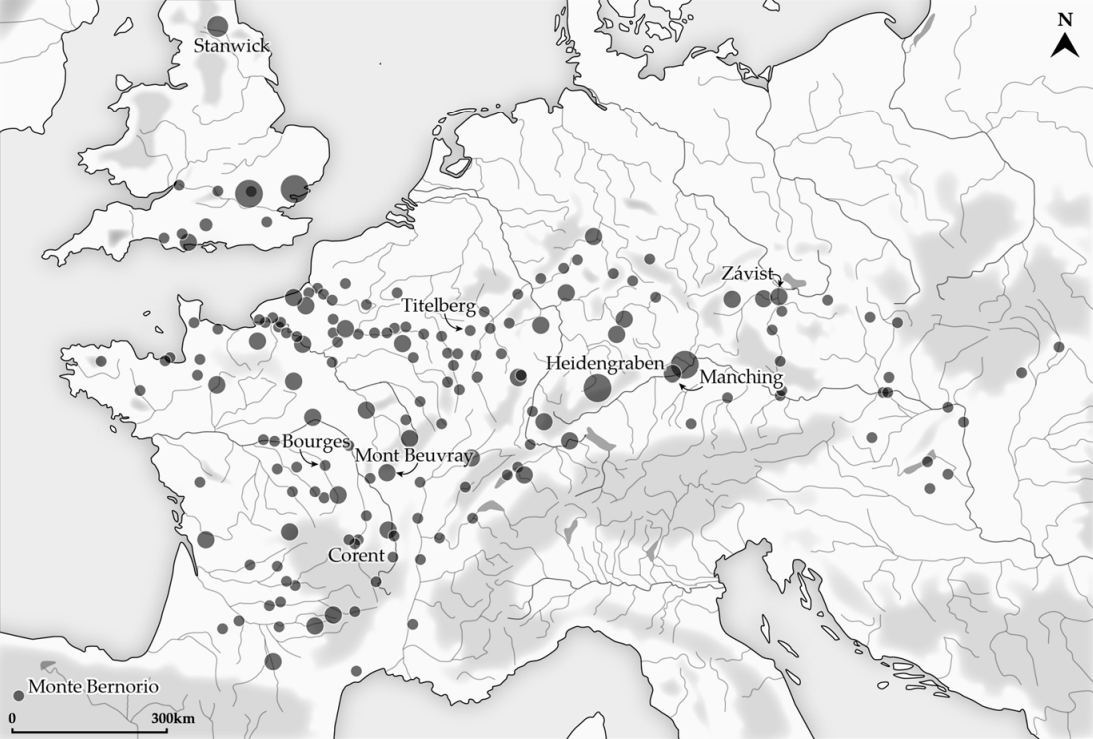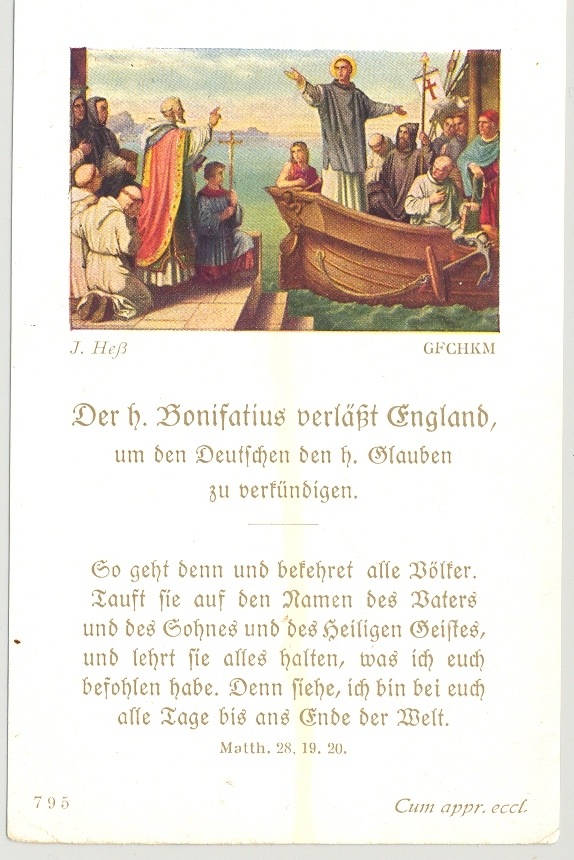|
Amöneburg
Amöneburg () is a town in the Marburg-Biedenkopf district in Hesse, Germany. It lies on a mountain and is built around the castle of the same name, ''Burg Amöneburg''. Geography Location Amöneburg lies on a basalt cone that can be seen from a great distance, below which flows the river Ohm, a tributary to the Lahn. From the Vogelsberg massif in the southeast, Amöneburg is split by the Amöneburg Basin, a hollow suspected of being a meteorite craterIn the southwest rise the Lahn Mountains. Neighbouring communities In the north, Amöneburg borders on the town of Kirchhain, in the east on the town of Stadtallendorf (both in Marburg-Biedenkopf), in the southeast on the town of Homberg (Vogelsbergkreis), and in the west on the community of Ebsdorfergrund (Marburg-Biedenkopf). Communities within town * Erfurtshausen * Mardorf * Roßdorf * Rüdigheim Coat of arms Amöneburg's coat of arms, like many throughout western Germany, depicts the Wheel of Mainz and Saint Mart ... [...More Info...] [...Related Items...] OR: [Wikipedia] [Google] [Baidu] |
Kirchhain
Kirchhain () is a town in Marburg-Biedenkopf district in Hesse, Germany. Geography Kirchhain is located in the heart of the state of Hesse in Marburg-Biedenkopf district. Geographically, it is surrounded by the Amöneburg Basin on the southeast edge of the ''Burgwald'' (a low mountain range) about 15 km east of Marburg on the rivers Ohm River, Ohm and Wohra. Neighbouring communities In the north, Kirchhain borders on the town of Rauschenberg, Hesse, Rauschenberg, in the east on the town of Stadtallendorf, in the south on the town of Amöneburg and the community of Cölbe. Town divisions Besides the main centre of Kirchhain with about 8,300 inhabitants, 12 further constituent communities share another 8,900 people: History In prehistoric times a network of long-distance and connecting trails crossed back and forth over the area where the town of Kirchhain was later to be founded. Since the early New Stone Age, there is evidence of almost continuous settlement in the area ... [...More Info...] [...Related Items...] OR: [Wikipedia] [Google] [Baidu] |
Wheel Of Mainz
The Wheel of Mainz or , in German language, German, was the coat of arms of the Archbishopric of Mainz and thus also of the Electorate of Mainz (Kurmainz), in Rhineland-Palatinate, Germany. It consists of a silver wheel with six spokes on a red background. The wheel can also be found in stonemasons' carvings (e.g. landmarks) and similar objects. Currently, the City of Mainz uses a double wheel connected by a silver cross. Origin The origins of the wheel are not known. One theory traces it back to Bishop Willigis, who was elected Archbishop of Mainz in 975. According to a tale delivered by the Brothers Grimm, his ancestors had been wheelwrights and his adversaries sneered at him for his mean birth. They drew wheels on the walls and doors of his residence, Willigis though made it his personal ensign with the motto "Willigis, remember where you came from". However, this is not proven, and in any case Coat of arms, coats of arms only appeared in the 12th century. Most of the archb ... [...More Info...] [...Related Items...] OR: [Wikipedia] [Google] [Baidu] |
Ebsdorfergrund
Ebsdorfergrund is a municipality consisting of eleven villages in the southeast of Marburg-Biedenkopf district in Hesse, Germany. The community's municipal area extends over the ''Ebsdorfer Grund'' in the valley of the Zwester Ohm and the areas around its edges, connecting the Amöneburg Basin with the middle Lahn valley between Marburg and Gießen. Through the municipal area runs a highway from Fronhausen (Autobahn interchange in Gießen by ''Bundesstraße'' B 3) to Kirchhain. Another one joins Marburg with Grünberg. The old ring railway, the ''Marburger Kreisbahn'', which opened in 1905 and ran through the municipal area to Dreihausen, was shut down in 1972. Neighbouring communities In the northwest, Ebsdorfergrund borders on the town of Marburg, in the north on the town of Kirchhain, in the northeast on the town of Amöneburg (all in Marburg-Biedenkopf) and the town of Homberg (Vogelsbergkreis), in the south on the community of Rabenau and the town of Allendorf, in the ... [...More Info...] [...Related Items...] OR: [Wikipedia] [Google] [Baidu] |
Stadtallendorf
Stadtallendorf is a town in the district of Marburg-Biedenkopf, Hesse, Germany. It lies about east of Marburg. In 2010, the town hosted the 50th Hessentag state festival. Geography Location Under the German system of ''Naturräume'', Stadtallendorf lies in the West Hesse Depression zone (''westhessische Senkenzone'') which is divided into basins and ridges. With respect to these, the town lies on the Upper Hesse Ridge which separates the Amöneburg Basin in the west from the ''Schwalmbecken'' (another basin) in the east. On this ridge may also be found the Neustadt Saddle, abutted by the town's northeast edge. This upland is part of the Water divide, divide between the Rhine and Weser Drainage basin, watersheds. Neighbouring communities Stadtallendorf borders in the north on the town of Rauschenberg, Hesse, Rauschenberg (Marburg-Biedenkopf) and the community of Gilserberg (Schwalm-Eder-Kreis), in the east on the town of Neustadt, Hesse, Neustadt, in the southeast on the to ... [...More Info...] [...Related Items...] OR: [Wikipedia] [Google] [Baidu] |
Ohm (river)
The Ohm (; older ''Amana''GREULE, Albrecht 2014. "Deutsches Gewässernamenbuch: Etymologie der Gewässernamen und der zugehörigen Gebiets-, Siedlungs- und Flurnamen". Ed. Walter de Gruyter GmbH) is a river in Hesse, Germany. It is a right tributary of the Lahn. Its total length is . The Ohm originates in the Vogelsberg Mountains, east of the town Ulrichstein. It flows generally northwest through Ulrichstein, Mücke, Homberg, Amöneburg, Kirchhain, and joins the Lahn in Cölbe, near Marburg Marburg (; ) is a college town, university town in the States of Germany, German federal state () of Hesse, capital of the Marburg-Biedenkopf Districts of Germany, district (). The town area spreads along the valley of the river Lahn and has .... Its largest tributaries are the Seenbach, Felda, Klein, Wohra and Rotes Wasser. References Rivers of Hesse Rivers of the Vogelsberg Vogelsberg Marburg-Biedenkopf Rivers of Germany {{Hesse-river-stub ... [...More Info...] [...Related Items...] OR: [Wikipedia] [Google] [Baidu] |
Homberg (Ohm)
Homberg (Ohm) () is a town in the Vogelsbergkreis in Hesse, Germany. Geography Location The officially recognized climatic spa of Homberg lies from 203 to 350 m above sea level in the valley of the Ohm (river), Ohm, a tributary to the Lahn, some 19 km southeast of Marburg. Neighbouring communities Homberg borders in the north on the town of Stadtallendorf (Marburg-Biedenkopf), in the northeast on the town of Kirtorf, in the southeast on the community of Gemünden (Felda), Gemünden, in the south on the community of Mücke, in the southwest on the town of Grünberg, Hesse, Grünberg and the community of Rabenau, Hesse, Rabenau (both in Gießen (district), Gießen district), in the west on the community of Ebsdorfergrund, and in the northwest on the town of Amöneburg (both in Marburg-Biedenkopf). Constituent communities The town of Homberg consists of not only the namesake main town, but also of the outlying centres of Appenrod, Bleidenrod, Büßfeld, Dannenrod, Deckenbach, E ... [...More Info...] [...Related Items...] OR: [Wikipedia] [Google] [Baidu] |
Oppidum
An ''oppidum'' (: ''oppida'') is a large fortified Iron Age Europe, Iron Age settlement or town. ''Oppida'' are primarily associated with the Celts, Celtic late La Tène culture, emerging during the 2nd and 1st centuries BC, spread across Europe, stretching from British Iron Age, Britain and Iberia in the west to the edge of the Great Hungarian Plain, Hungarian Plain in the east. These settlements continued to be used until the Romans conquered Southern and Western Europe. Many subsequently became Roman-era towns and cities, whilst others were abandoned. In regions north of the rivers Danube and Rhine, such as most of Germania, where the populations remained independent from Rome, ''oppida'' continued to be used into the 1st century AD. Definition is a Latin word meaning 'defended (fortified) administrative centre or town', originally used in reference to non-Roman towns as well as provincial towns under Roman control. The word is derived from the earlier Latin , 'encl ... [...More Info...] [...Related Items...] OR: [Wikipedia] [Google] [Baidu] |
Saint Boniface
Boniface, OSB (born Wynfreth; 675 –5 June 754) was an English Benedictines, Benedictine monk and leading figure in the Anglo-Saxon mission to the Germanic parts of Francia during the eighth century. He organised significant foundations of the Catholic Church in Germany, church in Germany and was made Elector of Mainz, Archbishop of Mainz by Pope Gregory III. He was martyred in Frisia in 754, along with 52 others, and his remains were returned to Fulda, where they rest in a sarcophagus which remains a site of Christian pilgrimage. Boniface's life and death as well as his work became widely known, there being a wealth of material available — a number of , especially the near-contemporary , legal documents, possibly some sermons, and above all his correspondence. He is venerated as a saint in the Christian church and became the patron saint of Germania, known as the "Apostle to the Germans". Norman Cantor notes the three roles Boniface played that made him "one of the truly ... [...More Info...] [...Related Items...] OR: [Wikipedia] [Google] [Baidu] |
Monastery
A monastery is a building or complex of buildings comprising the domestic quarters and workplaces of Monasticism, monastics, monks or nuns, whether living in Cenobitic monasticism, communities or alone (hermits). A monastery generally includes a place reserved for prayer which may be a chapel, Church (building), church, or temple, and may also serve as an Oratory (worship), oratory, or in the case of Cenobium, communities anything from a single building housing only one senior and two or three junior monks or nuns, to vast complexes and estates housing tens or hundreds. A monastery complex typically comprises a number of buildings which include a church, dormitory, cloister, refectory, library, Wiktionary:balneary, balneary and Hospital, infirmary and outlying Monastic grange, granges. Depending on the location, the monastic order and the occupation of its inhabitants, the complex may also include a wide range of buildings that facilitate self-sufficiency and service to the commun ... [...More Info...] [...Related Items...] OR: [Wikipedia] [Google] [Baidu] |
Church (building)
A church, church building, church house, or chapel is a building used for Christian worship church service, services and Christian religion, Christian activities. The earliest identified Christian church is a house church founded between 233 AD and 256 AD. ''Church'' is also used to describe a Church (congregation), body or an assembly of Christian believers, while "the Church" may be used to refer to the worldwide Christian religious community as a whole. In traditional Christian architecture, the plan view of a church often forms a Christian cross with the centre aisle and seating representing the vertical beam and the Church architecture#Characteristics of the early Christian church building, bema and altar forming the horizontal. Towers or domes may inspire contemplation of the heavens. Modern churches have a variety of architectural styles and layouts. Some buildings designed for other purposes have been converted to churches, while many original church buildings have bee ... [...More Info...] [...Related Items...] OR: [Wikipedia] [Google] [Baidu] |
New Stone Age
The Neolithic or New Stone Age (from Greek 'new' and 'stone') is an archaeological period, the final division of the Stone Age in Mesopotamia, Asia, Europe and Africa (c. 10,000 BCE to c. 2,000 BCE). It saw the Neolithic Revolution, a wide-ranging set of developments that appear to have arisen independently in several parts of the world. This "Neolithic package" included the introduction of farming, domestication of animals, and change from a hunter-gatherer lifestyle to one of settlement. The term 'Neolithic' was coined by Sir John Lubbock in 1865 as a refinement of the three-age system. The Neolithic began about 12,000 years ago, when farming appeared in the Epipalaeolithic Near East and Mesopotamia, and later in other parts of the world. It lasted in the Near East until the transitional period of the Chalcolithic (Copper Age) from about 6,500 years ago (4500 BCE), marked by the development of metallurgy, leading up to the Bronze Age and Iron Age. In other places, the N ... [...More Info...] [...Related Items...] OR: [Wikipedia] [Google] [Baidu] |
Burg Amöneburg De Merian Hassiae
The German word Burg means castle. Burg or Bürg may refer to: Places Placename element * '' -burg'', a combining form in Dutch, German and English placenames * Burg, a variant of burh, the fortified towns of Saxon England Settlements * Burg, Aargau, Switzerland * Burg, Bernkastel-Wittlich, Germany * Burg, Bitburg-Prüm, Germany * Burg, Brandenburg, Germany * Burg, Dithmarschen, Germany * Burg auf Fehmarn, Germany * Burg bei Magdeburg, Germany * Burg im Leimental, Switzerland * Den Burg, Netherlands * The Burg, Illinois, United States * Burg, Hautes-Pyrénées, France * Burg, Kilfinichen and Kilvickeon parish, Scotland * Melber, Kentucky, United States, also known as Burg Other uses * Burg (surname) or Bürg * Bürg (crater) * Burg (ship, 2003), a car ferry operating on Switzerland's Lake Zurich *Burgs (fast-food chain) See also * * Burgh (other) * Borg (other) * Bourg (other) * Borough and -bury, common English variants of burg * Burg ... [...More Info...] [...Related Items...] OR: [Wikipedia] [Google] [Baidu] |









